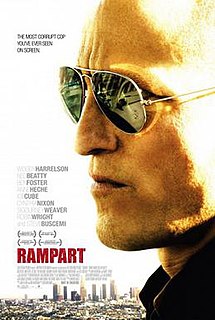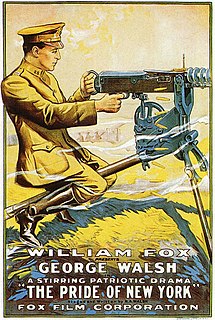
King Kong is a 1933 American pre-Code adventure fantasy horror monster film directed and produced by Merian C. Cooper and Ernest B. Schoedsack. The screenplay by James Ashmore Creelman and Ruth Rose was developed from an idea conceived by Cooper and Edgar Wallace. It stars Fay Wray, Robert Armstrong and Bruce Cabot, and tells the story of a giant ape dubbed Kong who attempts to possess a beautiful young woman. It features stop-motion animation by Willis O'Brien and a music score by Max Steiner. It is the first entry in the King Kong franchise.
David Holzman's Diary is a 1967 American mockumentary, or work of metacinema, directed by James McBride and starring L. M. Kit Carson. A feature-length film made on a tiny budget over several days, it is a work of experimental fiction presented as an autobiographical documentary. "A self-portrait by a fictional character in a real place—New York's Upper West Side," the film comments on David's personality and life as well as on documentary filmmaking and the medium of cinema more generally. In 1991, David Holzman's Diary was included in the annual selection of 25 motion pictures added to the National Film Registry of the Library of Congress. being deemed "culturally, historically, or aesthetically significant" and recommended for preservation.

Cool Hand Luke is a 1967 American prison drama film directed by Stuart Rosenberg, starring Paul Newman and featuring George Kennedy in an Oscar-winning performance. Newman stars in the title role as Luke, a prisoner in a Florida prison camp who refuses to submit to the system. Set in the early 1950s, it is based on Donn Pearce's 1965 novel Cool Hand Luke.

Magnolia is a 1999 American drama film written, directed and co-produced by Paul Thomas Anderson. It stars an ensemble cast, including Jeremy Blackman, Tom Cruise, Melinda Dillon, Philip Baker Hall, Philip Seymour Hoffman, Ricky Jay, William H. Macy, Alfred Molina, Julianne Moore, Michael Murphy, John C. Reilly, Jason Robards and Melora Walters. The film has a mosaic of interrelated characters in search of happiness, forgiveness, and meaning in the San Fernando Valley. The script was inspired by the music of Aimee Mann, who contributed several songs to its soundtrack.

A film transition is a technique used in the post-production process of film editing and video editing by which scenes or shots are combined. Most commonly this is through a normal cut to the next shot. Most films will also include selective use of other transitions, usually to convey a tone or mood, suggest the passage of time, or separate parts of the story. These other transitions may include dissolves, L cuts, fades, match cuts, and wipes.

Saul Bass was an American graphic designer and Oscar-winning filmmaker, best known for his design of motion-picture title sequences, film posters, and corporate logos.

W.R.: Mysteries of the Organism is a 1971 film by Serbian director Dušan Makavejev that explores the relationship between communist politics and sexuality, as well as presenting the controversial life and work of Austrian-American psychoanalyst Wilhelm Reich (1897–1957). The film's narrative structure is unconventional, intermixing fictional and documentary elements.

A film poster is a poster used to promote and advertise a film primarily to persuade paying customers into a theater to see it. Studios often print several posters that vary in size and content for various domestic and international markets. They normally contain an image with text. Today's posters often feature printed likenesses of the main actors. Prior to the 1980s, illustrations instead of photos were far more common. The text on film posters usually contains the film title in large lettering and often the names of the main actors. It may also include a tagline, the name of the director, names of characters, the release date, and other pertinent details to inform prospective viewers about the film.

In film, nudity may be either explicit or suggestive, such as when a person is seemingly naked but covered by a sheet. Since the birth of film, depictions of any form of sexuality have been controversial, and in the case of most nude scenes, had to be justified as part of the story.

Tarzan and His Mate is a 1934 American pre-Code action adventure film based on the Tarzan character created by Edgar Rice Burroughs. Directed by Cedric Gibbons, it was the second in the Tarzan film series and starred Johnny Weissmuller and Maureen O'Sullivan.
An eyeline match is a film editing technique associated with the continuity editing system. It is based on the premise that an audience will want to see what the character on-screen is seeing. An eyeline match begins with a character looking at something off-screen, followed by a cut of another object or person: for example, a shot showing a man looking off-screen is followed by a shot of a television. Given the audience's initial interest in the man's gaze, it is generally inferred on the basis of the second shot that the man in the first was looking at the television, even though the man is never seen looking at the television within the same shot.

Zack and Miri Make a Porno is a 2008 American sex comedy film written, directed and edited by Kevin Smith and starring Seth Rogen and Elizabeth Banks. It was released on October 31, 2008.
The Surprise of a Knight is a gay, hardcore pornographic film from the United States. Most likely released in 1929, it is notable for being the earliest known American pornographic film to depict exclusively homosexual intercourse.

The Red Ace is a 1917 American adventure film serial directed by Jacques Jaccard. An incomplete print which is missing four chapters survives in the film archive of the Library of Congress.
The Lion's Claws is a 1918 American adventure film serial directed by Harry Harvey and Jacques Jaccard and starring Marie Walcamp and Ray Hanford. The serial, which had 18 chapters, is considered to be a lost film.

Rampart is a 2011 American crime drama film. Directed by Oren Moverman and co-written by Moverman and James Ellroy, the film stars Woody Harrelson, Ned Beatty, Ben Foster, Anne Heche, Ice Cube, Cynthia Nixon, Sigourney Weaver, Robin Wright, and Steve Buscemi. It is set in the midst of the fallout from the Rampart scandal of the late 1990s, when corrupt Los Angeles Police Department Officer Dave Brown (Harrelson) is forced to face the consequences of his wayward career. The film premiered at the Toronto International Film Festival on September 10, 2011. and was released in theaters in the U.S. on February 10, 2012.

Sex in film, the presentation of aspects of sexuality in film, specially human sexuality, has been controversial since the development of the medium. Films which display or suggest sexual behavior have been criticized by religious groups or have been banned or censored by governments, although attitudes have changed much along the years and a more permissive social environment has developed in certain parts of the world, notably in the so called Western countries, that is the countries of Europe, North America, Australia and New Zealand. In countries with a film rating system, films which contain explicit sex scenes typically receive a restricted classification. Nudity in film may be regarded as sexual or as non-sexual.

Rough and Ready is a 1918 American silent Western film directed by Richard Stanton and produced and distributed by the Fox Film Corporation. It stars stage actor and western hero William Farnum. The picture was filmed in the Adirondack Mountains in western New York state. It is a lost film.

The House of Silence is a lost 1918 American silent drama film directed by Donald Crisp and written by Elwyn Alfred Barron and Margaret Turnbull. The film stars Wallace Reid, Ann Little, Adele Farrington, Winter Hall, Ernest Joy, and Henry A. Barrows. The film was released on April 8, 1918, by Paramount Pictures.

The Pride of New York is a lost 1917 American silent war drama film directed by Raoul Walsh and starring his brother George Walsh. It was produced by and distributed through the Fox Film Corporation.

















